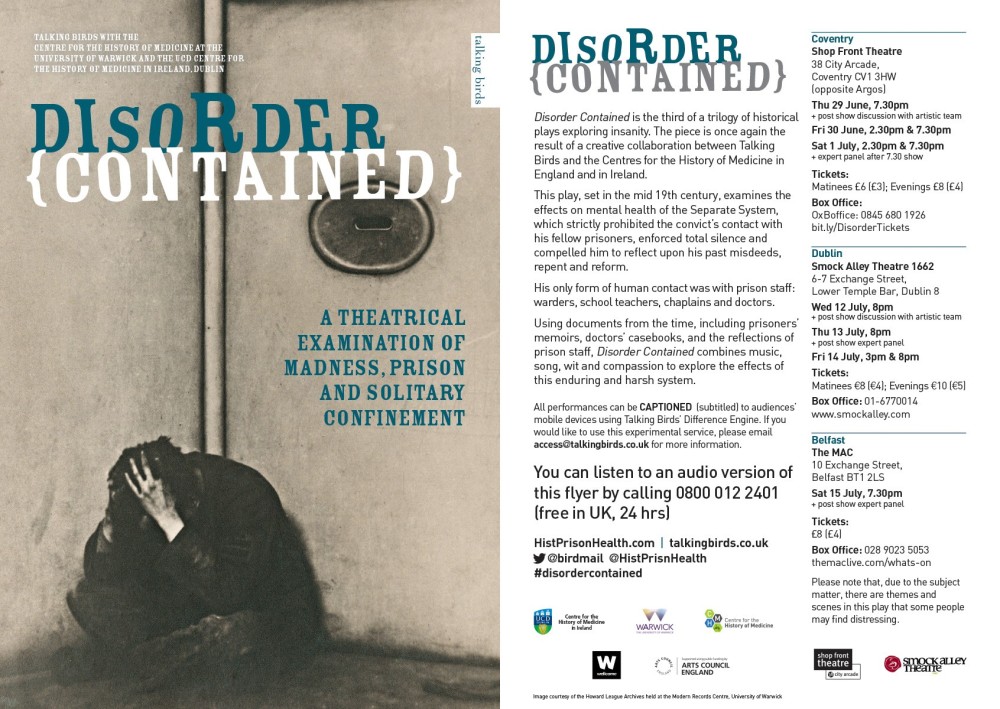Disorder Contained Theatrical Performance
Janet Vaughan, Talking Birds
The Iron Maiden
Yesterday afternoon, alone in the Shop Front Theatre varnishing parts of the set for Disorder Contained, I listened to the podcast of Hilary Mantel’s second Reith Lecture, ‘The Iron Maiden‘. She was navigating a complicated verbal path between the work of historians and authors of historical fiction, exploring the validity (and comparative value) of two very different approaches to, and renderings of, the past – and exploring more generally how the human mind can view one set of opinions as solid fact and another as slippery, less valid, conjecture.
Hilary Mantel asked ‘What can historical fiction bring to the table?… It doesn’t say “Believe this”, it says “Consider this”… It can sit alongside the work of historians, not offering an alternative truth, or even a supplementary truth, but offering insight.’
In this simple answer, she captured the essence of a successful collaboration with the past, characterising the strength of the arts (whether fiction, as in her own work, or theatre, as with Talking Birds) when partnered with the methodical – perhaps forensic is the right word – work of historians and those engaged in historical research.
Consider This
There are all kinds of interesting questions that any research project throws out, not least in consideration of the interpretational biases within the source materials, and the layer of interpretation brought to bear on those by the researcher. My understanding is that the historian must ask the right questions of their sources, use their imagination to draw their material together, find a narrative thread through the complex paper trail and put down the truths uncovered, so that we might better understand the past.
Whether or not it actually says ‘Believe this’, we generally do.
The artist’s process is actually pretty similar: sifting the research materials for the threads and connections that weave a story. The facts that jump out and spark the imagination; that provoke a double take; that demand some thinking about.
It absolutely says ‘Consider this’.
Disorder Contained
Talking Birds’ work explores the profound and complex relationships between people and place. In the case of Disorder Contained, this latest collaboration with Centres for the History of Medicine in England and Ireland, the people in question are convicts, and their place a whitewashed cell, no bigger than 13ft x 7ft x 9ft. Our sifted version of the research pulls together various disparate events into an unnamed mid-nineteenth-century prison, which could be in Britain or Ireland. Though the characters depicted are fictional, the incidents and arguments presented are based on reports and accounts from the time, taken directly from the research done by the teams at UCD and Warwick.
As artists working with this material, we have tried to imagine ourselves in the cells (or felt slippers, or polished boots) of the people confined in (or staffing, or making decisions about) these prisons; and to weave together many of the stories the research has unearthed. No one can really know how they might cope with being confined alone; where their mind might take them; and if they would meet this horror with fortitude, or as torture. But, as we have made this piece, we have ‘considered this’, and hope to offer glimpses and insights into this flawed reform system: to ask our audiences to also ‘Consider this.’ The combination of fictional context and live performance allows us to go one step further: as our audiences see the characters before them, and listen to the words of the prisoners and commissioners who lived (and suffered) through the Separate System, they cannot help but also consider how these stories might speak to our contemporary attitudes to mental health and prisons.
A Victorian Table Leg
The table leg I was varnishing as I listened to Hilary Mantel seemed somehow a fitting metaphor for this process of making art that asks us to consider history.
With the appearance of a shapely, turned, Victorian table leg supporting a sturdy Victorian table, the proportions are right, but the materials are ‘wrong’. For this shapely table leg is not a piece of solid wood that has been turned in a lathe, it is a stack of machined circles of plywood that impersonates, and stands in for, a Victorian table leg.
The reconstruction of the material may not be completely ‘Believe this’ accurate (nor is it an alternative or supplementary truth), but its very existence helps us to visualise the historical table, offering us an opportunity to examine the table from different angles and in four dimensions, provoking fresh or unexpected views or insights, giving us something to think about.
It asks us to ‘Consider this’ – to momentarily exist in both the past and the present ‘ – and then allows us to return and see, and to understand, our modern tables through slightly changed eyes.
Image Credit: A Victorian Table Leg. Photograph by Janet Vaughan
Book Tickets for Disorder Contained
- London from 9 – 10 October: Book tickets
Past Shows
- Coventry from 29 June – 1 July: Book tickets
- Dublin from 12 – 14 July: Book tickets
- Belfast on 15 July: Book tickets
See Also
- Show announcement
- Press release
- Theatre dates and tickets
- Audio flyer
- Reflective blogs (on translating historical research into accessible theatre)
- Disorder Contained: Reading

One Comment Add yours